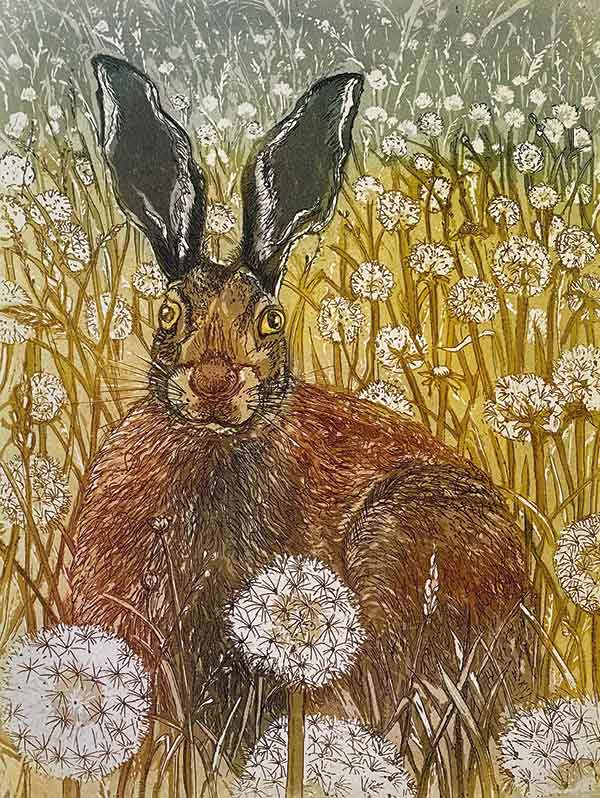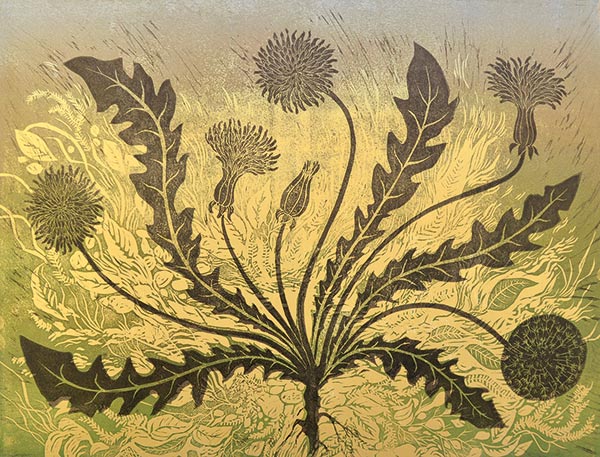Subtotal: $
Checkout-

A Wilderness God
-

Why I Hunt
-

Reading the Book of Nature
-

Breakwater
-

Lambing Season
-

Earthworks Urban Farm
-

Are You a Tree?
-

Practicing Christianity
-

Who Gets to Tell the Story?
-

A Medievalist Looks for the Image of Christ
-

In Defense of Chastity
-

Poem: “Let Them Grow”
-

Poem: “Squall”
-

Readers Respond
-

GEDs for Myanmar Migrants
-

Inside Nyansa Classical Community
-

Watching the Geminids
-

A World Full of Signs
-

Covering the Cover: The Riddle of Nature
-

Back from Walden Pond
-

Can Masculinity Be Good?
-

Nature Is Obsessed with Me
-

Ancient Songs in the Desert
-

The Sadness of the Creatures
-

Meeting the Wolf
-

Saskatchewan, Promised Land
-

The Plants Can Talk
-

Saving the Soil, Saving the Farm
-

The Wonder of Moths
-

The Leper of Abercuawg

Dandelions: An Apology
Why sweat lawn care when you could have a meadow, green and gold, by working a little less?
By Clare Coffey
March 19, 2024
Spring and early summer have always been, to me, powerfully associated with the color yellow.
First comes the forsythia, whose cut branches can be forced into bloom in the warmth of a home before the frost and rawness of winter dissipate. Forsythia is the pioneer, the first promise; later the waving daffodils that Wordsworth went on about.
In the Pacific Northwest, Oregon grape, which ends the summer with dark, glossy, spiked leaves and useful powdery-blue berries, begins dramatically differently, in a cloud of bright yellow blossoms.
The forsythia is yellow, the daffodils are yellow, Oregon grape blooms yellow, the bees darting among them are banded with yellow. Yellow, too, tints the cream produced on spring’s newly lush, abundant pastures. Every week, a farmer with a Jersey cow drops off a pint of cream and a gallon of milk at my house. The cream-topped milk is not the blinding white we usually associate with a frothy glass of our daily recommended vitamin D. There is a soft, muted, but rich tint of gold, as if a lingering imprint of the sun that fed the pastures that fed the cow is reflected in the milk that feeds me. It’s this reflective quality, this shadow made of light, that gives its name to the buttercup, another of spring’s yellow flowers: hold it under your chin, and if you like butter (so the saying goes) it will cast a faint gleam upwards.

Sally Winter, Time Lord, etching with aquatint, 2022. Artwork copyright © Sally Winter. Used by permission.
Buttercups can also be the impossibly vibrant color of the first, startling lumps of butterfat. When I make butter from my weekly cream (the best butter of the year, as the spring grass grows fast and sweet) nothing happens for the first interminable ten minutes or so. With the melancholy of the alchemist, I resign myself to nothing more exciting than whipped cream on my baked potatoes. But suddenly, yellow lumps appear. As I blend and blend, then knead and squeeze, watching the fatty solids slowly separate themselves from the liquid, the pale gold of the cream grows stronger and richer. When I pour off the buttermilk, it’s as if I am unveiling a molten core.
Robert Frost’s famous line “Nature’s first green is gold” has been interpreted in many ways: as a thought about innocence, youth, hope. I think it’s about butter.
But unlike in Frost’s poignant poem, in springtime, nature’s first green both comes from gold and returns to gold. The sun that feeds the pastures that tint the cream recreates its own image in the big orange-yellow yolks of eggs, laid in profusion by the scratching chickens and nibbling ducks at this time of year. It is in the “beestings” colostrum that feeds new calves. It is in the new Yukon potatoes that slept in the earth all winter. It dots the green pastures with flowers. It is the chick hatching out of the egg. Yellow is everywhere in the spring and summer, because yellow is the color of new life, of life in abundance.
We greet this symphony of yellow, for the most part, with open arms. But there is one element of the yearly turn to gold that does not spark gladness in the popular heart.
It is the dandelion.
The dandelion’s name, from the French dent-de-lion, comes from its serrated leaf, which calls to mind a lion’s tooth. But something about the whole plant is leonine: not only the sharp-edged foliage, but the long yellow petals that form clusters like shaggy heads, and the lion-hearted moxie with which it shows up, uncared for, unwanted, year after year, all over the world.
The dandelion is not considered one of the glories of spring. It is a weed, a pest, a noxious invader, an enemy. It is, along with crabgrass, the foremost enemy of the manicured lawn. There is some reason for this. Dandelions are incredibly hardy, due to their deep taproots, and spread easily via wind over a wide range. You do not want these tough little urchins competing with some more delicate garden princess that you are trying to gently shelter and pamper to maturity. Just the other day, I saw one growing a little too near to one of my camas lilies. I ripped it up by the root without regret and left it lying there as a warning to its friends.
But the wholesale hatred of dandelions is not usually driven by their discrete incursions against any particular herbaceous border. The dandelions are summertime enemy number one insofar as they appear in the lawn: a space that is by definition void of flowerbeds and complex cultivation. Much ink has justly been spilled on the paradoxes of the American front lawn: how maintaining wide swaths of turf grass originated in pastoral societies in wet climates and became a status symbol in climates with neither sheep to graze nor rain to water; how the sweeping manorial expanse of green became the pocket-sized yard defended with nearly as much feudal vigor.
Is summer really the time for finding more reasons to work? No. It is the time to receive gratefully the abundance of creation, the symphony of yellow. The planting-out time of early spring is behind you, the harvest time is coming. Now is the moment to lie in the hammock sipping dandelion mead.
The transformation is charming, perhaps even noble: it tracks with an American instinct that all people are entitled to something of their very own, something to cherish and build and bequeath, that the working man’s cottage is as important and dignified as the rich man’s castle. But it is hard not to feel that, in the random process of cultural entrenchment, that instinct has become perverted by being squandered on an unworthy object. The lawn is a deceptive dead end, a false door in a pharaoh’s tomb, a cartoon tunnel painted by Wile E. Coyote. It is one of our most irrigated crops and yet it produces nothing. It can demand finicky maintenance, a rhythm of care around which an entire masculine persona can be built, and yet the Eden all these Adams make is mostly a green wasteland, an absence. The lawn does not require wise harmonizing of disparate forms of life, the kind of true rule worthy of the suburban king. It yields no fruitfulness, in color and form, in food, or at the level of the soil. It demands water and an endless campaign of suppression. Even as a blank space for human activity, the lawn is a failure: people are much more likely to play football or eat dinner in their backyard than in their front, since the very flatness and emptiness of the front lawn creates a kind of merciless exposure to the street.
There is no place for the dandelion in this aspirationally sterile monoculture, which is a shame. Dandelions take almost no work to cultivate, and yet they return an abundance: not only of beauty – of cheerful yellow manes that break up a flat expanse of turf and gossamer seed heads that provide playful wish-magic to children – but in food. Every part of the dandelion is useful. The roots can be roasted into a bitter herbal coffee, pickled, eaten young like a radish, or infused into a digestive tincture. The leaves can be dried as an herbal tea that supports the liver. The fresh greens are loaded with vitamins. When young, they are a delicate, spicy alternative to the more widely sought-after arugula: eat them in a salad, tossed with a mustard vinaigrette underneath soft-boiled duck eggs. The older, more bitter, tougher leaves can be slow-braised with pork belly, or chopped and fermented into a condiment.

Tricia Newell, Dandelion, limited edition etching, 2019. Used by permission.
The best part of the dandelion, though, in my opinion, is the leonine head. Picked, destemmed, infused in water and left to ferment with raw honey, they become something magical: a dandelion mead that is part tonic, part wine, all effervescent summertime joy and bottled sunshine.
The utility of the dandelion, of course, depends on whether its host lawn has been sprayed with the toxic herbicides sold specifically to combat them. In fact, companies such as Monsanto largely enabled the current state of total war on dandelions, by developing innovative products such as Roundup that allow homeowners to selectively spray weeds without killing grass. Roundup’s website currently reminds you that killing invasive weeds (like dandelions) is an important act of public service: “Invasive weeds can take over an area and displace native plants, which can have negative ecological consequences. In some cases, invasive weeds can even threaten entire ecosystems.”
It is ironic that Roundup has positioned itself as a tool in the service of native plants, since native plants are usually touted as the antithesis to lawns, the paradise we could achieve if we escaped the brainwashing of Big Turf. Rip up your lawn, goes the advice, kill your grass, and in the spring plant a meadow of wildflowers, beds of shrubs and forbs, elderberry and chokecherry and echinacea, perhaps even a small pond, and see monarch butterflies and native bees and all manner of birds and insects, field mice, and frogs, enjoying the bounty of a local ecosystem flourishing under the summer sun.
“The dandelion holds itself no longer for its own keeping, only as something to be given; a breath does the rest, turning the ‘readiness to will’ into the ‘performance.’”
—Lilias Trotter
It is certainly a beautiful picture. I cannot say a word against it. But it makes me a bit melancholy that even among the anti-lawn crusaders, the useful, spunky, beautiful dandelion is something between an afterthought and a nuisance.
Besides, the native plant garden paradise takes a lot of work: successfully killing your turf, planning, purchasing, planting, mulching, weeding, experimenting with what works and what doesn’t or paying for the advice of experts. It is good work. But many people with lawns are not looking for more work: they enjoy lawn work precisely because it feels like a sort of minimum manageable standard of care for their environment.
To these people, then, I would make my pitch: just do a little less. You can have a meadow, green and gold, dotted with the ease and abundance of summer, a feast for the eyes and the body and the bees, all by working a little less. And is summer really the time for finding more reasons to work? No. It is the time to receive gratefully the abundance of creation, the symphony of yellow. The planting-out time of early spring is behind you, the harvest time is coming. Now is the moment to lie in the hammock sipping dandelion mead.
I do not know if this will convince anyone. I think perhaps the dandelion requires a poet, not an essayist, to make its case. Walt Whitman’s “The First Dandelion” has never attained quite the universal recognition of other odes to spring flowers, perhaps from a misapprehension of the dandelion as a gentle innocent rather than a brave scrapper:
Simple and fresh and fair from winter’s close
emerging,
As if no artifice of fashion, business, politics,
had ever been,
Forth from its sunny nook of shelter’d grass—
innocent, golden, calm as the dawn,
The spring’s first dandelion shows its trustful
face.
But if the dandelion’s Wordsworth has yet to appear, it has already been the occasion for meditation. Lilias Trotter, a missionary, writer, and artist in the nineteenth and early twentieth centuries, wrote:
This dandelion has long ago surrendered its golden petals, and has reached its crowning stage of dying – the delicate seed-globe must break up now – it gives and gives till it has nothing left.
What a revolution would come over the world – the world of starving bodies at home, the world of starving souls abroad – if something like this were the standard of giving; if God’s people ventured on “making themselves poor” as Jesus did, for the sake of the need around; if the “I” – “me” – “mine” were practically delivered up, no longer to be recognized when they clash with those needs.
The hour of this new dying is clearly defined to the dandelion globe; it is marked by detachment. There is no sense of wrenching; it stands ready, holding up its little life, not knowing when or where or how the wind that bloweth where it listeth may carry it away. It holds itself no longer for its own keeping, only as something to be given; a breath does the rest, turning the “readiness to will” into the “performance” (2 Cor. 8:11). And to a soul that through “deaths oft” has been brought to this point, even acts that look as if they must involve an effort become something natural, spontaneous, full of a “heavenly involuntariness,” so simply are they the outcome of the indwelling love of Christ.
The dandelion is an obvious sign of the love of Christ: as Trotter notes, for its uncalculating, diffusive self-emptying; for the artist Raphael, its bitterness and spikes serve as a symbol of the Passion. Perhaps, too, its many powers of health and healing to the body, and the evocation of the Lion of Judah in its name, its teeth, its fierce little head, invite the comparison.
And perhaps the very scorn we heap on dandelions is for this reason another hopeful sign. Welcome or not, judged as weed or flower, tormented with herbicides or cradled in the hands of children, the dandelion always comes back. It appears every year under the summer sun, growing everywhere, indifferent to our protestations, offering itself as nourishment and joy for all who care to taste its bounty.
Already a subscriber? Sign in
Try 3 months of unlimited access. Start your FREE TRIAL today. Cancel anytime.









































Nicole Coonradt
The Spell Songs/Lost Words collaboration (original book by Robert Macfarlane, illustrated by Jackie Morris) pays tribute to the dandelion in the beautiful song "Scatterseed" (by Kris Drever). My favorite line: "I hear you roaring, 'Death to lawn perfection.'" Scatterseed Spin me round tiny time machine, They used to call you Lion's tooth or windblow, They used to call you milkwitch or parachute, They used to call you evening glow Scatterseed, Scatterseed, the fallen star of the football field, Let new names take, let them thrive and grow, Dazzle me you little sun of the grass, I hear you roaring, death to lawn perfection, The timepiece no longer known as. Scatterseed, Scatterseed, the fallen star of the football field, Scatterseed, Scatterseed, I’d never call you ‘just a weed’.
Sonya Woolston
As my husband will tell you, the dandelion has always been my favorite flower, precisely for its "here I am again, like it or not!" persona. There are few pictures more beautiful than a medow of gold, and few things more delightfully surprising than a brave little golden head pushing up through a crack in the cement sidewalk. We cultivate vegetables for a living, so technically the dandelion should be a pest. Yet each time we are on hands and knees weeding the greenhouse and find one of these sweet pests, it is tenderly plucked and brought to me by one of my boys "here Mom, for your hair". Thanks for the further insight on my favorite flower!
Diana Micklos
Ah, the diminutive but persistent dandelion. I like to think of it as a reminder from God that we are NOT in control.
Jennifer Howland
This was a lovely tribute on so many levels. Our fields are daffodil-filled. Daffodils have some “annoying” characteristics similar to dandelions, but the next county over gave up and made them the official flower with an annual festival. However, one field was replaced with solar panels, and behold, the field next to it every Spring yields—buttercups. Can’t keep the yellow at bay no matter what form it takes. Hallelujah!